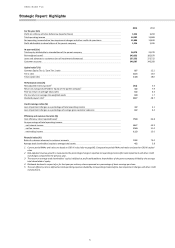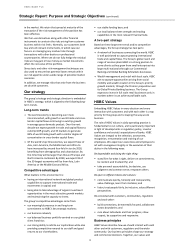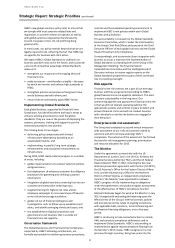HSBC 2014 Annual Report Download - page 13
Download and view the complete annual report
Please find page 13 of the 2014 HSBC annual report below. You can navigate through the pages in the report by either clicking on the pages listed below, or by using the keyword search tool below to find specific information within the annual report.
HSBC BANK PLC
Strategic Report: Strategic Priorities (continued)
11
• capturing growth opportunities in home and priority
growth markets, particularly from group collaboration
by accessing owners and principals of CMB and
GB&M clients; and
• repositioning the business to concentrate on onshore
markets and a smaller number of target offshore
markets, aligned with Group priorities.
Implementing Global Standards, enhancing risk
management controls, tax transparency and simplifying
processes also remain top priorities for GPB.
Key Performance Indicators
The Board of Directors tracks the group’s progress in
implementing its strategy with a range of financial and
non-financial measures or key performance indicators.
Progress is assessed by comparison with the group
strategic priorities, operating plan targets and historical
performance.
From time to time the group reviews its key performance
indicators (‘KPIs’) in light of its strategic objectives and
may adopt new or refined measures to better align the
KPIs to HSBC’s strategy and strategic priorities.
Financial KPIs
2014
2013
%
%
Risk adjusted revenue growth
(3.6)
5.6
Cost efficiency ratio
79.8
66.8
Pre
-tax return on average risk-
weighted
assets
ratio
0.8
1.7
CET 1 / Core tier 1 capital ratio
8.7
12.1
Risk-adjusted revenue growth is measured as the
percentage change in reported net operating income
after loan impairment and other credit risk charges since
last year. The group seeks to deliver consistent growth in
risk-adjusted revenues.
Outcome: Reported risk-adjusted revenue growth
decreased primarily due to weaker trading income
compared to 2013.
Cost efficiency ratio is measured as total operating
expenses divided by net operating income before loan
impairment and other credit risk provisions.
Outcome: The cost efficiency ratio increased principally
due to higher costs, most notably from charges for
investigations into foreign exchange, combined with
lower overall revenues.
Pre-tax return on average risk-weighted assets ratio is
measured as pre-tax profit divided by average risk-
weighted assets. The group targets a return in the
medium term of between 1.8 and 2.0 per cent.
Outcome: The return on average risk-weighted assets
was significantly below the target range predominantly
due to a fall in profit before tax.
Common equity tier / Core tier 1 capital ratio –
represents the ratio of common equity tier / core tier 1
capital comprising shareholders’ equity and related non-
controlling interests less regulatory deductions and
adjustments to total risk weighted assets. The group
seeks to maintain a strong capital base to support the
development of its business and meet regulatory capital
requirements at all times.
Outcome: The Common Equity Tier 1 ratio fell compared
to Core Tier 1 ratio from 12.1 to 8.7 per cent primarily
reflecting the impact of the transition to CRD IV.
Employee engagement
Strong employee engagement leads to positive
commercial outcomes and underpins improved business
performance, increased customer satisfaction, higher
productivity, talent retention and reduced absenteeism.
We assess our employees’ engagement through our
Global People Surveys, which were held annually from
2007 to 2011 and bi-annually thereafter. The latest
Survey, in 2013, focused on supporting a values-led high
performance culture by assessing if our employees were
engaged in the Group’s purpose and felt able to deliver
on our ambition to become the world’s leading
international bank.
The overall Europe engagement score in 2013 was 60 per
cent, which was below the financial services norm.
Strong scores were registered in risk awareness (78 per
cent, 5 percentage points above the external best-in-
class), employee development (58 per cent), leadership
capability (58 per cent) and living the HSBC Values (78
per cent). Aspects that require concerted attention
included pride and advocacy, which had fallen from 2011
levels. The next Global People Survey will be conducted
in 2015.
Brand value
HSBC monitors the strength of its brand through an
empirical tool (the Brand Equity Index), which combines
measurements of perception for customer purchase
consideration from the brand, customer advocacy of the
brand and emotional connection to the brand to develop
an Index Value that can be tracked over time.
The HSBC brand in the UK scores at the competitive
average, ranking third, and is strongly differentiated
from an International perspective. In both Turkey and
France, HSBC's Brand Equity Index improved during 2014
but is below the average of its larger local competitors.
Customer service and satisfaction
In RBWM, customer satisfaction is measured through an
independent market research survey of retail banking
customers, using a Customer Recommendation Index
(‘CRI’) to score performance. In the UK during 2014 our
CRI ranking was poor and for the first half of the year,
the bank achieved historic low scores. Following a strong
intervention programme in our service channel
'Simplifying Growth' we saw a positive response and
finished the year with a very good fourth quarter
position ranking us joint third behind Halifax and
Santander. Turkey and France both saw significant
improvement throughout the year and both achieved
their targets to improve their overall score relative to the
competitor average. Turkey in particular finished the
fourth quarter strongly with a record competitive joint
third position in the market.
Throughout 2014, CMB continued to draw insight and
metrics from the Client Engagement Programme (‘CEP’),
conducted by an independent third party. The results
























